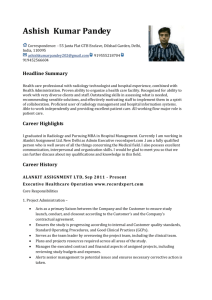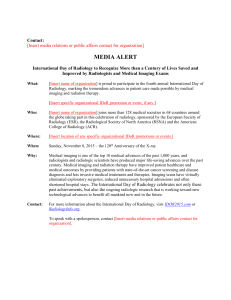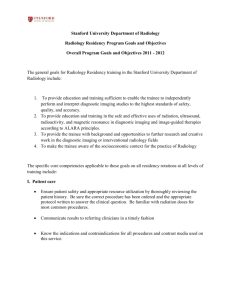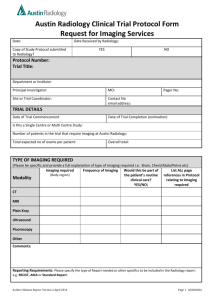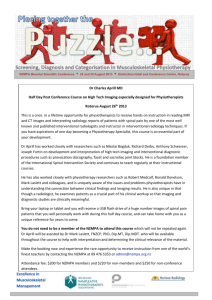fmCASES Blueprint: The Practice of Dr
advertisement
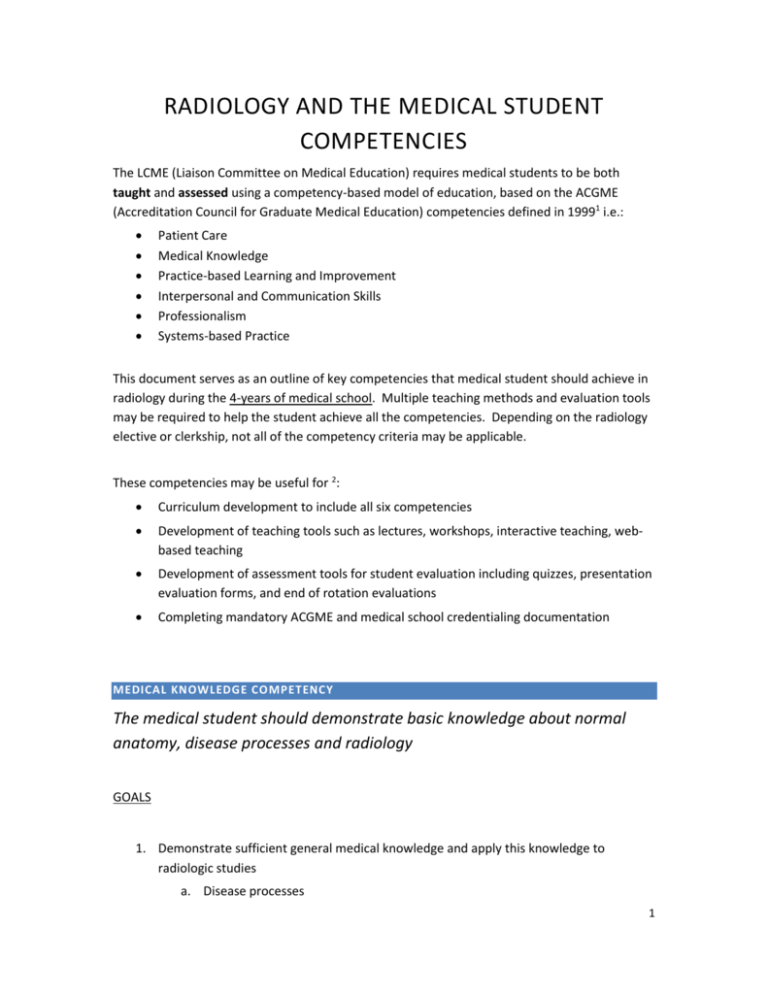
RADIOLOGY AND THE MEDICAL STUDENT COMPETENCIES The LCME (Liaison Committee on Medical Education) requires medical students to be both taught and assessed using a competency-based model of education, based on the ACGME (Accreditation Council for Graduate Medical Education) competencies defined in 19991 i.e.: Patient Care Medical Knowledge Practice-based Learning and Improvement Interpersonal and Communication Skills Professionalism Systems-based Practice This document serves as an outline of key competencies that medical student should achieve in radiology during the 4-years of medical school. Multiple teaching methods and evaluation tools may be required to help the student achieve all the competencies. Depending on the radiology elective or clerkship, not all of the competency criteria may be applicable. These competencies may be useful for 2: Curriculum development to include all six competencies Development of teaching tools such as lectures, workshops, interactive teaching, webbased teaching Development of assessment tools for student evaluation including quizzes, presentation evaluation forms, and end of rotation evaluations Completing mandatory ACGME and medical school credentialing documentation MEDICAL KNOWLEDGE COMPETENCY The medical student should demonstrate basic knowledge about normal anatomy, disease processes and radiology GOALS 1. Demonstrate sufficient general medical knowledge and apply this knowledge to radiologic studies a. Disease processes 1 b. Disease presentations c. Disease progression and prognosis d. Appropriate therapies 2. Demonstrate radiological knowledge a. Understand common radiological modalities i. How they are used to generate adequate diagnostic images ii. What affects the image appearance on different modalities (tissue composition) iii. Common radiologic terminology (opacity, echogenicity) iv. Pros and cons of imaging modalities in different clinical situation v. ACR Appropriateness Criteria for Imaging© common conditions b. Radiological findings in common diseases on typical modalities c. Accuracy of different modalities in common conditions LEARNING TOOLS Small and large group didactic sessions Participation in departmental and interdepartmental case conferences Participation in the clinical activities of the radiology department View Box (PACS) teaching Web-based modules Preparation of a case-based talk during the radiology rotation ASSESSMENT TOOLS AMSER shelf-exam or institution specific exam using AMSER ExamWeb Quizzes Evaluation of observed informed consent Objective structured clinical examination (OSCE) Global rating by residents, fellows and faculty who worked with the student PATIENT CARE COMPETE NCIES 2 The medical student should provide patient care that is safe, compassionate and effective in the diagnosis and management of common health problems. GOALS 1. Diagnostic management skills a. Know how to order appropriate imaging tests i. Utilize the ACR (American College of Radiology) Appropriateness Criteria™ ii. Include patient variables into imaging selection b. Understand the importance of providing appropriate information on the radiology request form (history, physical, risk and limiting factors) so radiology can perform appropriate modality selection, protocolling, interpretation and billing 2. Information retrieval skills a. Know how to access images and view them i. Understand the basics of a PACS workstation ii. Understand windows, levels, image linking, etc. b. Know how to access imaging reports: preliminary and final c. Perform effective, rapid clinical information search 3. Visual interpretative skills a. Know basic radiological anatomy b. Understand the factors that affect image appearance and quality c. Understand the importance of using prior comparison studies d. Recognize normal and common or critical abnormal findings on basic radiographic studies including abdominal radiographs, chest radiographs, radiographs of the bones and joints, etc. 4. Interventional skills a. Understand the different types of interventional procedures performed by radiology and the effectiveness of those procedures i. Diagnostic procedures e.g. biopsies ii. Therapeutic procedures e.g. embolizations 3 b. Understand how to work up a patient for basic interventional procedures e.g. indications and contraindications, alternative treatments, consequences to no treatment. c. Assist in basic interventional procedures e.g. paracentesis with ultrasound guidance (only occurs in some clerkships/electives) 5. Information processing skills a. Synthesize history, physical exam and imaging findings to make appropriate differential diagnoses b. Correctly interpret radiology reports 6. Patient safety and radiation exposure a. Understand the risks of imaging including physical, financial and emotional i. Radiation risk (ionizing) to patients and operators and methods to reduce radiation exposure ii. Contrast material risks iii. MRI safety iv. Pregnant patients and imaging v. Interventional procure risks LEARNING TOOLS Integration and application of ACR Appropriateness criteria during small and large group didactic and case-based sessions discussing imaging for specific clinical questions. Small group discussion of shared decision making and informed consent o Role playing of the consent process with the students alternating being the patient and the radiologist Observe informed consent for imaging/interventional procedures Observe discussion with pregnant patient regarding radiation and contrast risk Didactic presentation on safety of imaging procedures and contraindications Web based module on safety of imaging procedures Simulators or phantoms to practice ultrasound guidance for venous access Informatics web based module Mock patient work ups for procedures ASSESSMENT TOOLS Global ratings by residents, fellows and faculty 4 360-degree evaluation of communication skills and behavior on the rotation (evaluation by residents, fellows, attendings, technologists, patients) Self assessment at the end of the rotation (can use same form as global rating by residents, fellows and faculty) Log of procedures that were observed ExamWeb quiz including questions on patient safety Direct observation and assessment of performance (eg. informed consent, counsel patient regarding contrast allergy or radiation risk) Standardized patient exam (complete screening form, counsel pregnant patient prior to CT) OSCE Demonstration of interventional skills using simulators or phantoms Written clinical notes Patient write up PRACTICE-BASED LEARNING AND IMPROVEMENT The medical student(s) should continually seek to improve their knowledge and skills by multiple means, be able to self-evaluate and apply new knowledge to his or her practice. GOALS 1. Use of information technology and data resources a. Demonstrate awareness of key sources of data for performing evidence-based medicine i. Use established medical algorithms (Ottawa ankle rule, Ottawa knee rule, NEXUS criteria for cervical spine imaging) ii. Use National society guidelines for imaging (eg. Neurology stroke protocol, back pain, first trimester bleeding) b. Use evidence based methods for selecting imaging modalities i. ACR Appropriateness Criteria® c. Effectively search for additional information i. Use validated sources (ie. ‘Beyond the Google™’, such as Pubmed) ii. Know when additional information is needed and search spontaneously 5 2. Perform critical assessment of the literature a. Show an awareness of current literature on common problems b. Research presentation topics appropriately using peer reviewed literature c. Appropriately interpret the results of scientific studies (eg. Validity of study) d. Be aware of some of the limitations of scientific studies (eg. Power, sample size, control subjects) 3. Application of learning a. Effectively apply newly learned information to appropriate clinical settings i. Develop new skills ii. Apply newly acquired knowledge and skills in the appropriate clinical setting iii. Be able to propose changes in the patient care plan based on the outcomes of imaging studies b. Demonstrate improvement in existing skills and develop new skills c. LEARNING TOOLS Journal clubs, small group or independent critical assessment of scientific literature Didactic small or large group sessions on assessment of scientific literature Participation in departmental conferences including mortality and morbidity as well as quality improvement conferences ASSESSMENT TOOLS Evaluation of critical assessment of scientific literature during a journal club, case conference or while on a rotation Quiz on ACR Appropriateness Criteria® use OSCE station on how to perform a search on a topic using the internet INTERPERSONAL COMMUNICATION COMPETENCY The medical student can communicate and interact effectively with patients and healthcare providers. GOALS 6 1. Interactions with patients a. Interacts effectively with patients i. Be compassionate, friendly, professional ii. Be able to take an effective history iii. Can calm anxious patients iv. Be able to develop a potentially therapeutic relationship v. Be able to give appropriate information within their knowledge, ability and level of responsibility 2. Interactions with physicians a. With radiologists (staff and residents) i. Be respectful, but not inhibited from asking questions ii. Ask appropriate insightful questions that gain knowledge iii. Not be overly intrusive, be aware of time limitations iv. Help with information technology, patient management, communication v. Understand the importance of the radiologist-clinician interaction b. With clinicians i. Can gather appropriate clinical information about patients/study requests ii. Can communicate results effectively to clinicians if asked 3. Interactions with technologists/nurses a. Exhibit respectful interactions and treat them as a member of the team b. Are aware of the knowledge and training of paramedical staff 4. Written communication skills a. Documents clinical data effectively when needed (e.g. electronic medical record) b. Understands need for recording of urgent findings c. Provides relevant clinical history on requisitions for medical imaging 5. Presentation skills a. Presents fluent, well-researched presentation b. Shows understanding of topic c. Conveys information succinctly and memorably to audience LEARNING TOOLS 7 Small group session on communicating results to patients Small group session on informed consent Preparation of a presentation while on the rotation Web based module on reporting urgent imaging findings Collection of reading references on guidelines how to tell patients imaging results (Smith, Gunderman Radiology 2010 255:317-321) Journal club presentations Participation in case conferences and interdisciplinary conferences ASSESSMENT TOOLS 360 degree evaluation by technologists, nurses, residents, fellows and radiology faculty of communication skills Evaluation of a prepared oral presentation Evaluation of journal club presentation OSCE station on the importance of communicating urgent imaging findings OSCE station to assess obtaining informed consent OSCE station to assess communicating imaging findings to a patient OSCE station to assess communicating with clinicians (ex. communicating with clinician who is requesting a test that may not be indicated) PROFESSIONALISM COMP ETENCY The medical student should demonstrate a commitment to carrying out professional responsibilities and an adherence to ethical principles. GOALS 1. Demonstrate appropriate skills a. Maintains professional and medical competence by continuing to self-learn throughout career b. Seeks help and support when identifies a knowledge gap c. Continually gathers new scientific knowledge d. Strives to improve the quality of patient care by practicing at the highest level of quality 8 2. Demonstrates appropriate behaviors a. Meets professional responsibilities by working as a member of a team b. Demonstrates honesty with patients and all members of the health care team c. Respects patient confidentiality with all information transmitted during a patient encounter d. Maintains appropriate relationships with patients to prevent boundary transgression 3. Demonstrates social justice and service a. Works to improve access to care for those patients with limited resources b. Considers just distribution of finite sources when selecting imaging tests c. Understands issues around conflict of interest, avoids interaction with industry for personal advantage and discloses any existing conflicts of interest LEARNING TOOLS Journal clubs on ethics and professionalism in Radiology AMSER Professionalism module available on MedEdPORTAL Small group case-based discussion on professionalism issues should include debriefing sessions Case-log/diary of cases and patients that brought up professionalism issues ASSESSMENT TOOLS 360 degree evaluation by technologists, nurses, residents, fellows and radiology faculty of professional behavior AMSER Professionalism module before and after test available on MedEdPORTAL OSCE station to assess professionalism issues (ex. confidentiality with patient images, conflict of interest, HIPAA) SYSTEMS-BASED PRACTICE COMPETENCY 9 The student demonstrates awareness of the complexities, interactions and considerations involved in working in the modern health care environment. (i.e. the “culture” of the workplace) GOALS 1. Demonstrate awareness of the goal of cost effective imaging a. Aware of common examination charges b. Understands the basic concepts of costs and reimbursement c. Understands the financial impact on patients and society of imaging i. Understands the importance of performing appropriate imaging ii. Appreciates potential future limitations to imaging availability 2. Understands the workflow patterns in radiology for effective patient management, study ordering etc 3. Demonstrates effective communication between radiology and clinicians a. Appreciates the importance of the radiology-clinician interaction (verbal, written) b. Appreciates the importance of prioritizing studies based on study urgency c. Understands the importance of prompt preliminary reports d. Understands the process of dealing with discrepancies between preliminary and final reports 4. Understands the impact of medical radiation exposure on potential cancer risk for population as a whole a. Demonstrates knowledge of current data regarding risk b. Aware of need for reducing unnecessary imaging LEARNING TOOLS Small or large group didactic session on cost effectiveness of imaging studies Small group workshop on workflow of patients in radiology to become effective at study ordering and implications of study results including potential need for more tests Participation in departmental and multidisciplinary conferences that discuss appropriate imaging evaluation of specific diseases and cost-effectiveness ACR/APDR videotapes on non-interpretive skills that discuss systems-based practice 10 ASSESSMENT TOOLS 1 360 degree evaluation by technologists, nurses, residents, fellows and radiology faculty of professional behavior Attendance log at case conferences and multidisciplinary conferences OSCE station on cost-effectiveness and appropriateness of imaging tests Questions from ExamWeb on cost-effectiveness and prioritization of imaging tests http://www.acgme.org/outcome/comp/compmin.asp 2 Collins J General Competencies in Radiology Residency Training: Definitions, Skills, Education and Assessment. Academic Radiology 2002; 9:721-726. Petra Lewis 1-27-2011 Andrea Donovan 03-02-2012 11

